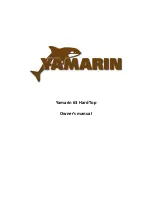
Sport Fish
1-8
Chapter 1
Every six hours the National Weather Service issues marine forecasts for
coastal ares of the U.S. , for offshore water and the high seas. Each forecast
covers a different coastal area. It contains a summary of the weather
patterns in and around the area, plus a prediction of winds, seas, weather
and visibility.
Meteorologists affiliated with radio and TV stations, also offer good marine
forecasts for popular boating areas. Tune into one of these sources of
weather information to get the current weather picture before setting out.
Countless lives have been saved by advance warnings of approaching
severe weather. Marine weather warnings are unique because of the special
relationship between wind and waves. The longer the wind blows in a
steady direction and the greater the distance over the water, the higher and
more powerful the waves. Wind stress on the water builds the wave. Wind
of 35 knots may create a 6-foot wave in just two hours; those are considered
“severe conditions” for most marine activities. The wind/wave relationship is
evident in the range of marine weather warnings.
Weather Information
While on the water, the best way to receive timely weather information is by
radio. NOAA Weather Radio (NWR), operated by the National Weather
Service, provides continuous weather programming for all U.S. waters. For
weather broad casts and their frequencies, see the following chart.
WEATHER RADIO
BROADCAST FREQUENCIES
BROADCASTER
FREQUENCIES
NOAA Weather Radio
162.550 MHz (WX-1)
(Range approx.
162.400 MHz (WX-2)
40 miles)
162.475 MHz (WX-3)
Coast Guard Marine
2670.0 kH
Information Stations
4428.7 kH
6506.4 kH
8765.4 kH
13113.2 kH
VHF (Channel 22A)
157.1 MHz
National Bureau of Standards
5 MHz
Time and Frequency Service
10 MHz
15 MHz
Scout Boats Section 1.qxd:Scout Boats Section 1.qxd 5/11/07 5:35 AM Page 8
Summary of Contents for 145
Page 40: ...Scout Boats 2 10 Chapter 2 ...
Page 76: ...Scout Boats 6 8 6 Chapter 6 ...
Page 102: ...Scout Boats 10 8 Chapter 10 ...
Page 111: ......















































